The Apple Thunderbolt Display Review
by Anand Lal Shimpi on September 23, 2011 2:56 AM EST- Posted in
- Displays
- Mac
- Apple
- Thunderbolt
- Thunderbolt Display
Dissection
If you haven't gathered by now, the Thunderbolt Display isn't a regular monitor - it has a lot of components inside that you'd typically only find in a full fledged computer. Being the curious cat I am, I wanted to see inside. Apple isn't too fond of us poking around inside their review samples, but luckily the Crabtree Valley Mall Apple Store just got Thunderbolt Displays in so I hopped in the practical-wagon and grabbed one in the name of science.
Apple has an incredible fascination with using magnets in its designs. What it enables are some pretty neat enclosures, particularly on its displays. The glass front of the Thunderbolt Display is actually identical to what's used on the 27-inch LED Cinema Display and iMac. The glass is held to the chassis via several very strong magnets. To remove the glass you'll need to use suction cups:
Behind the glass front is the actual LCD panel itself. The LCD and backlight are enclosed in a single unit. What we're interested in is behind the LCD however. Unplug a few cables and remove a grounding screw and the LCD unit is easily cast aside. Behind it are two discrete PCBs:
The PCB on the left is the monitor's power supply. Looking at another half-wave rectifier isn't on my to-do list this time, so we turn our attention to the right PCB. This is the board that handles all of the IO on the Thunderbolt Display. All of the screws we've removed thus far just need a T9/T10 torx bit.
The Thunderbolt Display's motherboard is full of controllers driving all of the rear facing IO ports. Contrary to what we originally posted, I now believe this is the same Light Ridge controller we've seen on other Macs (not the MacBook Air):
The external Thunderbolt cable actually continues inside the display and ends up at an internal Thunderbolt port. The cable terminates at the port and then is routed via traces on the PCB to the Eagle Ridge chip:
The other controllers are sprinkled around the PCB, although there's enough space between all of them to make routing nice and easy. The beauty of designing PCBs for monitors like this is you have tons of room to work with.
Pericom provides a PCIe x1 to 4-USB-port adapter on the board:
The internal speakers are driven by a combination of an ST-NXP 0161ET USB audio controller and an Analog Devices ADAV4601 audio processor. The ST-NXP controller sits on an internal USB interface, while the ADAV4601 dangles off of it.
That wraps it up for the front of the PCB. Around back there's a collection of stereo amps as well as the GigE (Broadcom BCM57761) and FW800 (LSI L-FW643E-2) controllers.
There's nothing immediately apparent in the PCB design that would point to the cause of the issue we saw with the Promise Pegasus interfering with the Thunderbolt Display's USB audio controller. The root cause must be exclusive to the Pegasus.








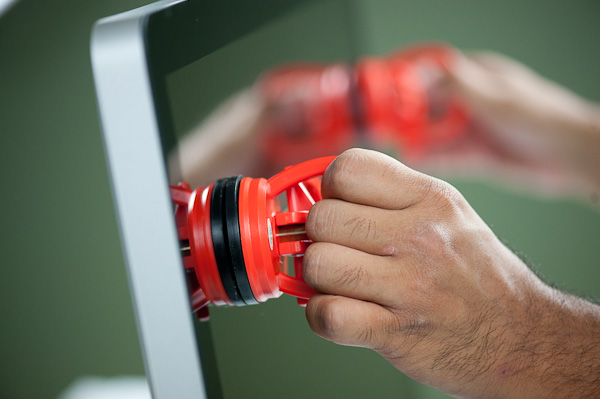
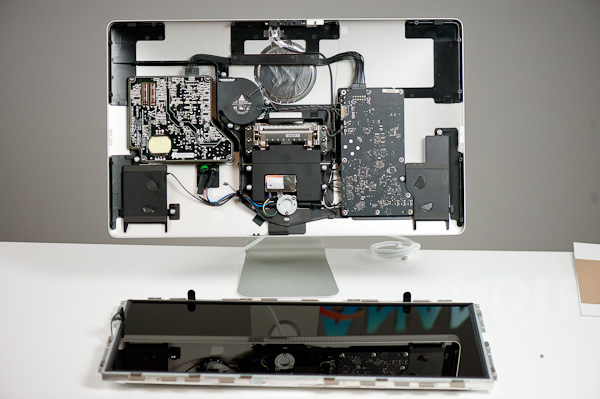
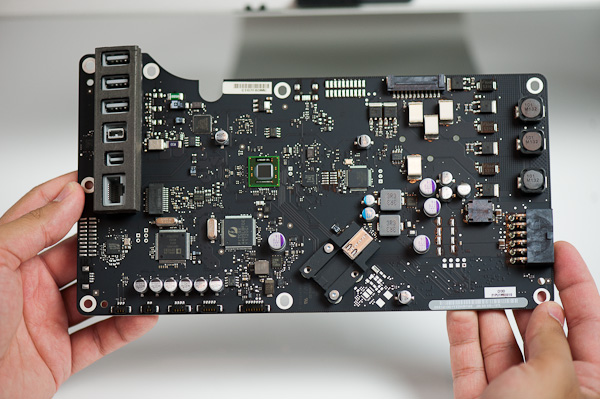
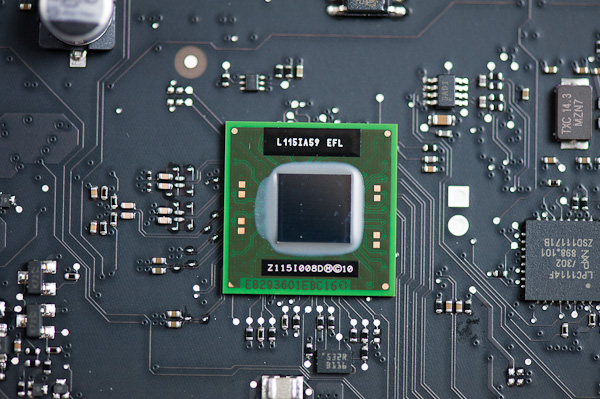
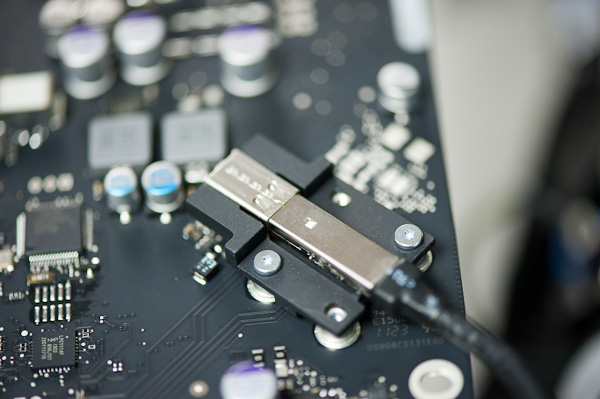
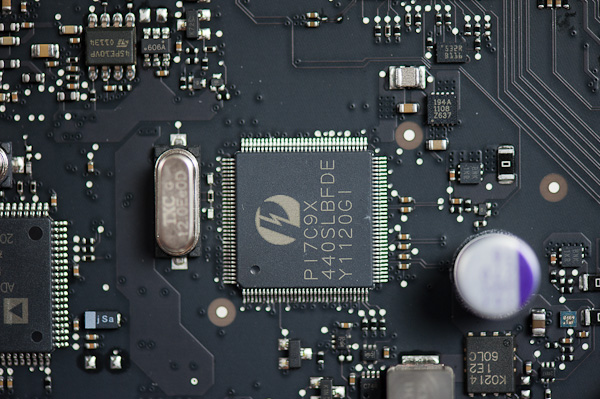
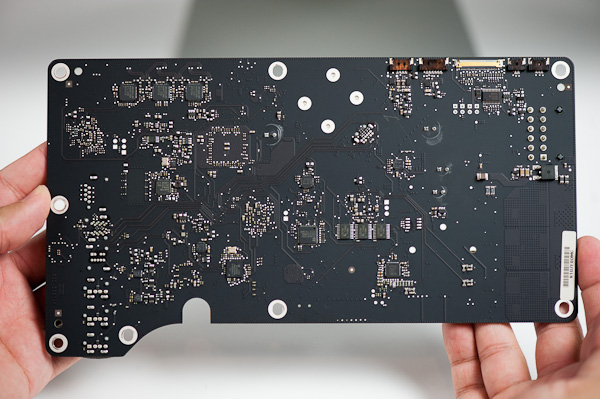
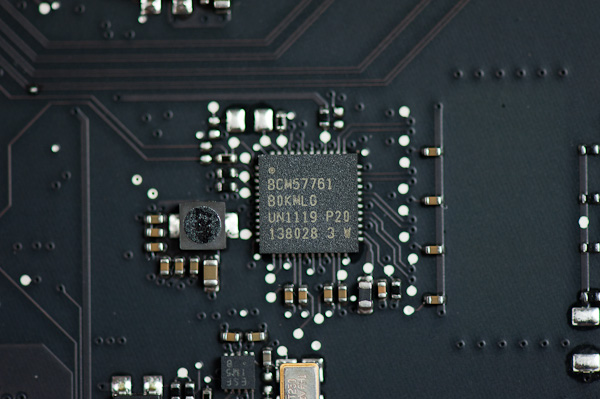








275 Comments
View All Comments
name99 - Friday, September 23, 2011 - link
"The iMac and displays like this compell people to discard those expensive displays far ahead of their time and likely buy another display of the same size and resolution."And discard means WHAT? I can go to eBay and see the prices for second hand macs. What's stopping you from selling your iMac, or giving it to a friend/family member/school?
You claim there area significant number of still-working flat-screen iMacs in closets or the trash. I call bullshit.
dave1_nyc - Friday, September 23, 2011 - link
Anand, I liked the review, and I think this sounds like interesting technology, but honestly, but you sound as though you've never used a docking station. Yes, you're right, they are all proprietary, but the good ones from Dell and Toshiba (and I'm sure others) are terrifically useful if one needs one.I don't, but there are people in my org for whom their laptops are their main machines and they take them back and forth between the office and home every day. All the modern docking stations provide pretty much any connectivity you could want, and they allow you to use any monitor you want, and switch out monitors.
Further, while connecting two cables (a la the review) isn't hard, with the laptops and docking stations we have you walk up and set the laptop down onto the station connectors. At which time the laptop (if thus setup) turns on, adjusts for the external display (or two), and that's that. If you have automatic login, you never have to open the laptop.
Expensive? We pay $150 for them, and with that comes the freedom to upgrade either the docking station (such as when the USB 3 ones come out early next year) or the monitor independently of each other.
Of course, the real docking stations (as opposed to those USB 2 things) are only found in 'business class' machines, but those machine can now be configured with discrete graphics if one wants.
I'm not trying to sell docking stations, but you're usually not quite so inaccurately dismissive.
jecs - Friday, September 23, 2011 - link
I agree with you. I think Apple or someone else should produce a docking station for Mac Books. I remember when I used those with an IBM laptop some years ago.If you want to use "an all Apple technology" the thunderbolt display is fine. But if you want a MBP and have a different need you will find yourself limited in options. But those parts need to be competitive in price and quality.
Constructor - Friday, September 23, 2011 - link
Why are you limited? Simply use a different Thunderbolt docking solution instead of the ready-made Thunderbolt Display.With Thunderbolt you can even customize your own special solution in a way you never could before, by daisy-chaining multiple Thunderbolt devices according to your own specific needs.
And the kicker is that you can carry it all over to a new machine, even when switching manufacturers and even platforms!
None of the pre-existing docking solutions ever came close to that.
Trefugl - Saturday, September 24, 2011 - link
But where are all these external devices that I can so easily purchase and make my own docking solution? Last I checked (admittedly a few weeks ago), there was a very limited selection on adapter types on the market.I do agree that this is a great solution (and one that actually makes me excited about thunderbolt), the problem is that no one has made an external hub like what's in the display yet... they might now that PCs are getting the same connector next year, but it just blows my mind that the first place you see this tech is stuffed inside a monitor (one that only can work at all with new '11 Macbooks...)
Constructor - Saturday, September 24, 2011 - link
Well, it works with all current Macs (the Mac Pro is the only one that hasn't been upgraded to Thunderbolt yet).And I would not be surprised if the availability of Intel Thunderbolt controllers was one of the reasons why third party devices are being delayed – at the number of Macs Apple is producing, it is quite possible they're buying every chip Intel manages to get out the door. But Intel has lots of experience with mass production of high-grade chips, so I have no doubt availability will catch up soon if it hasn't already.
Belkin is apparently designing effectively a Thunderbolt Display without the display:
http://gizmodo.com/5839952/belkins-thunderbolt-exp...">Belkin's Thunderbolt Express Dock Finally Gives You a Reason to Remember You Have Thunderbolt
And there's more in the pipeline from various manufacturers. Unsurprisingly, professional-grade interfaces which actually need the speed and low latency are among the first.
Constructor - Saturday, September 24, 2011 - link
The link has been crippled, apparently. This should work:http://gizmodo.com/5839952/belkins-thunderbolt-exp...
AbRASiON - Friday, September 23, 2011 - link
Defective by design.stepa - Friday, September 23, 2011 - link
Simple question (requires a simple answer)So does it mean that there is no way to connect this display to a windows pc as a main display?i know that with previous models you could use an adapter or newer gfx cards already have a display port.so this a no go for pc users?
KPOM - Friday, September 23, 2011 - link
Not until PCs with Thunderbolt ports start coming out next year. I suspect a lot of the Ultrabooks will do so since Thunderbolt support will be built into some of the Ivy Bridge chipsets.